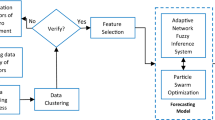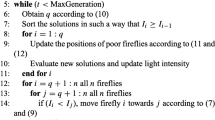Abstract
Sales forecasting plays a very important role in business operation. Many researches generally employ statistical methods, such as regression or auto-regressive integrated moving average model, to forecast the product sales. However, they only can consider the quantitative data. Some exogenous qualitative variables have more influence on forecasting result. Thus, this study attempts to propose a integrated forecasting system which is able to consider both quantitative and qualitative factors to achieve a more comprehensive result. Basically, fuzzy neural network is first employed to capture the expert knowledge regarding some qualitative factors. Then, it is combined with the time series data using an artificial immune system based back-propagation neural network. A laptop sales data set provided by a distributor in Taiwan is applied to verify the proposed approach. The computational result indicates that the proposed approach is superior to other forecasting methods. It can be used to decrease the inventory costs and enhance the customer satisfaction.








Similar content being viewed by others
References
Azadeh, A., Moghaddam, M., Khakzed, M., & Ebrahimipour, V. (2012). A flexible neural network-fuzzy mathematical programming algorithm for improvement of oil price estimation and forecasting. Computers & Industrial Engineering, 62, 421–430.
Aydin, I., Karakose, M., & Akin, E. (2010). An adaptive artificial immune system for fault classification. Journal of Intelligent Manufacturing, 23(5), 1489–1499.
Chang, P. C., Wang, Y. W., & Tsai, C. Y. (2005). Evolving neural network for printed circuit board sales. Expert Systems with Applications, 29(1), 83–92.
Dasgupta, D., & Gonzalez, F. (2002). An immunity-based technique to characterize intrusions in computer networks. IEEE Transaction On Evolutionary Computation, 6(3), 281–291.
De Castro, L. N., & Timmis, J. (2002a). An artificial immune network for multimodal function optimization. Proceedings of the IEEE World Congress on Evolutionary computation (pp. 699–704).
De Castro, L. N., & Timmis, J. (2002b). Artificial immune systems: a novel paradigm to pattern recognition. In Artificial Neural Networks in Pattern Recognition (pp. 67–84), UK: University of Paisley.
De Castro, L. N., & Timmis, J. (2003). Artificial immune systems as a novel soft computing paradigm. Soft Computing, 7(8), 526–544.
De Castro, L. N., & Zuben, F. J. V. (2002). Learning and optimization using the clonal selection principle. IEEE Transactions on Evolutionary Computation, 6, 239–251.
Deng, W., Chen, R., Gao, J., Song, Y., & Xu, J. (2012). A novel parallel hybrid intelligence optimization algorithm for a function approximation problem. Computers and Mathematics with Applications, 63, 325–336.
Diao, Y., & Passino, K. M. (2002). Immunity-based hybrid learning methods for approximator structure and parameter adjustment. Engineering Applications of Artificial Intelligence, 15, 587–600.
El-Abd, M. (2012). Performance assessment of foraging algorithms vs. evolutionary algorithms. Information Sciences, 182, 243–263.
Fu, X., Li, A., Wang, L., & Ji, C. (2011). Short-term scheduling of cascade reservoirs using an immune algorithm-based particle swarm optimization. Computers and Mathematics with Applications, 62(6), 2463–2471.
Hadavandi, E., Shavandi, H., & Ghanbari, A. (2010). Integration of genetic fuzzy systems and artificial neural networks for stock price forecasting. Knowledge-Based Systems, 23, 800–808.
Hadavandi, E., Shavandi, H., Ghanbari, A., & Naghneh, S. A. (2012). Developing a hybrid artificial intelligence model for outpatient visits forecasting in hospitals. Applied Soft Computing, 12, 700–711.
Hong, W. C. (2010). Application of chaotic ant swarm optimization in electric load forecasting. Energy Policy, 38, 5830–5839.
Hornik, K., Stinchocombe, M., & White, H. (1989). Multilayer feed-forward networks are universal approximators. Neural Networks, 2, 359–366.
Huang, P. T. B. (2014). An intelligent neural-fuzzy model for an in-process surface roughness monitoring system in end milling operations. Journal of Intelligent Manufacturing. doi:10.1007/s10845-014-0907-6.
Jang, J. S. R. (1993). ANFIS: Adaptive-network-based fuzzy inference system. IEEE Transactions on system, Man, and Cybernetics, 23(3), 665–685.
Jansen, T., & Zarges, C. (2011). Analyzing different variants of immune inspired somatic contiguous hypermutations. Theoretical Computer Science, 412, 517–533.
Jardin, P. D., & Severin, E. (2012). Forecasting financial failure using a Kohonen map: A comparative study to improve model stability over time. European Journal of Operational Research, 221, 378–396.
Katherasan, D., Elias, J. V., Sathiya, P., & Haq, A. N. (2014). Simulation and parameter optimization of flux cored arc welding using artificial neural network and particle swarm optimization algorithm. Journal of Intelligent Manufacturing, 25, 67–76.
Kovac, P., Rodic, D., Pucovsky, V., & Savkovic, B. (2013). Application of fuzzy logic and regression analysis for modeling surface roughness in face milling. Journal of Intelligent Manufacturing, 24, 755–762.
Khashei, M., & Bijari, M. (2012). Hybridization of the probabilistic neural networks with feed-forward neural networks for forecasting. Engineering Applications of Artificial Intelligence, 25, 1277–1288.
Kuo, R. J., & Cohen, P. H. (1998). Manufacturing process control through integration of neural networks and fuzzy model. Fuzzy Sets and Systems, 98(1), 15–31.
Kuo, R. J. (2001). A sales forecasting system based on fuzzy neural network with initial weights generated by genetic algorithm. European Journal of Operational Research, 129(3), 496–517.
Kuo, R. J., Wu, P. C., & Wang, C. P. (2002). An intelligent sales forecasting system through integration of artificial neural networks and fuzzy neural networks with fuzzy weight-elimination. Neural Networks, 15(7), 909–925.
Kuo, R. J., Hong, S. Y., & Huang, Y. C. (2010). Integration of particle swarm optimization-based fuzzy neural network and artificial neural network for supplier selection. Applied Mathematical Modelling, 34(12), 3976–3990.
Kuo, R. J., Tseng, W. L., Tien, F. C., & Liao, W. T. (2012). Application of an artificial immune system-based fuzzy neural network to a RFID-based positioning system. Computers & Industrial Engineering, 63(4), 943–956.
Kuo, R. J., & Chang, J. W. (2014). Intelligent RFID positions system through immune-based feed-forward neural network. Journal of Intelligent Manufacturing. doi:10.1007/s10845-013-0832-0.
Lin, C. T., & Lee, C. S. G. (1991). Neural-network-based fuzzy logic control and decision system. IEEE Transactions on Computer, 40(12), 1320–1336.
Lin, G. F., & Wu, M. C. (2011). An RBF network with a two-step learning algorithm for developing a reservoir inflow forecasting model. Journal of Hydrology, 405, 439–450.
Lu, C. J., & Wang, Y. W. (2010). Combining independent component analysis and growing hierarchical self-organizing maps with support vector regression in product demand forecasting. International Journal of Production Economics, 128, 603–613.
Mamdani, E. H. (1974). Application of fuzzy algorithms for control of simple dynamic plant. Proceedings of the Institution of Electrical Engineers, 121(12), 1585–1588.
Qasem, S. N., Shamsuddin, S. M., & Zain, A. M. (2012). Multi-objective hybrid evolutionary algorithms for radial basis function neural network design. Knowledge-Based Systems, 27, 475–497.
Qiu, X., & Lau, H. Y. K. (2014). An AIS-based hybrid algorithm for static job shop scheduling problem. Journal of Intelligent Manufacturing, 25, 489–503.
Roitt, I., & Brostoff, J. (1998). Immunology. New York: Mosby Int. Ltd.
Rumelhart, D. E., Hinton, G. E., & Williams, R. J. (1986). Learning representation by back propagation errors. Nature, 323, 533–536.
Shibata, T., Fukuda, T., Kosuge, T., & Arai, F. (1992). Skill based control by using fuzzy neural network for hierarchical intelligent control. In Proceedings of IJCNN’92 (Vol. 2, pp. 81–86).
Taguchi, G., Chowdhury, S., & Wu, Y. (2005). Taguchi’s quality engineering handbook. NJ: Wiley, Hoboken.
Takagi, T., & Sugeno, M. (1985). Fuzzy identification of systems and its applications to modeling and control. IEEE Transactions on Systems, Man, and Cybernetics, 15(1), 116–132.
Teimouri, R., & Baseri, H. (2014). Forward and backward predictions of the friction stir welding parameters using fuzzy-artificial bee colony-imperialist competitive algorithm systems. Journal of Intelligent Manufacturing. doi:10.1007/s10845-013-0784-4.
Tien, J. P., & Li, T. H. S. (2012). Hybrid Taguchi-chaos of multilevel immune and the artificial bee colony algorithm for parameter identification of chaotic systems. Computers and Mathematics with Applications, 64, 1108–1119.
Wei, Y., & Chen, M. C. (2012). Forecasting the short-term metro passenger flow with empirical mode decomposition and neural networks. Transportation Research Part C, 21, 148–162.
Yudong, Z., & Lenan, W. (2009). Stock market prediction of S&P 500 via combination of improved BCO approach and BP neural network. Expert Systems with Applications, 36, 8849–8854.
Zadeh, L. A. (1994). Fuzzy logic, neural networks, and soft computing. Communications of the ACM, 37(3), 77–84.
Zadeh, L. A. (1965). Fuzzy sets. Information and Control, 8(3), 338–353.
Zhao, H. Q., & Zhang, J. S. (2008). Functional link neural network cascaded with Chebyshev orthogonal polynomial for nonlinear channel equalization. Signal Processing, 88(8), 1946–1957.
Zhou, S., Lai, K. K., & Yen, J. (2012). A dynamic meta-learning rate-based model for gold market forecasting. Expert Systems with Applications, 39, 6168–6173.
Author information
Authors and Affiliations
Corresponding author
Rights and permissions
About this article
Cite this article
Kuo, R.J., Tseng, Y.S. & Chen, ZY. Integration of fuzzy neural network and artificial immune system-based back-propagation neural network for sales forecasting using qualitative and quantitative data. J Intell Manuf 27, 1191–1207 (2016). https://doi.org/10.1007/s10845-014-0944-1
Received:
Accepted:
Published:
Issue Date:
DOI: https://doi.org/10.1007/s10845-014-0944-1




